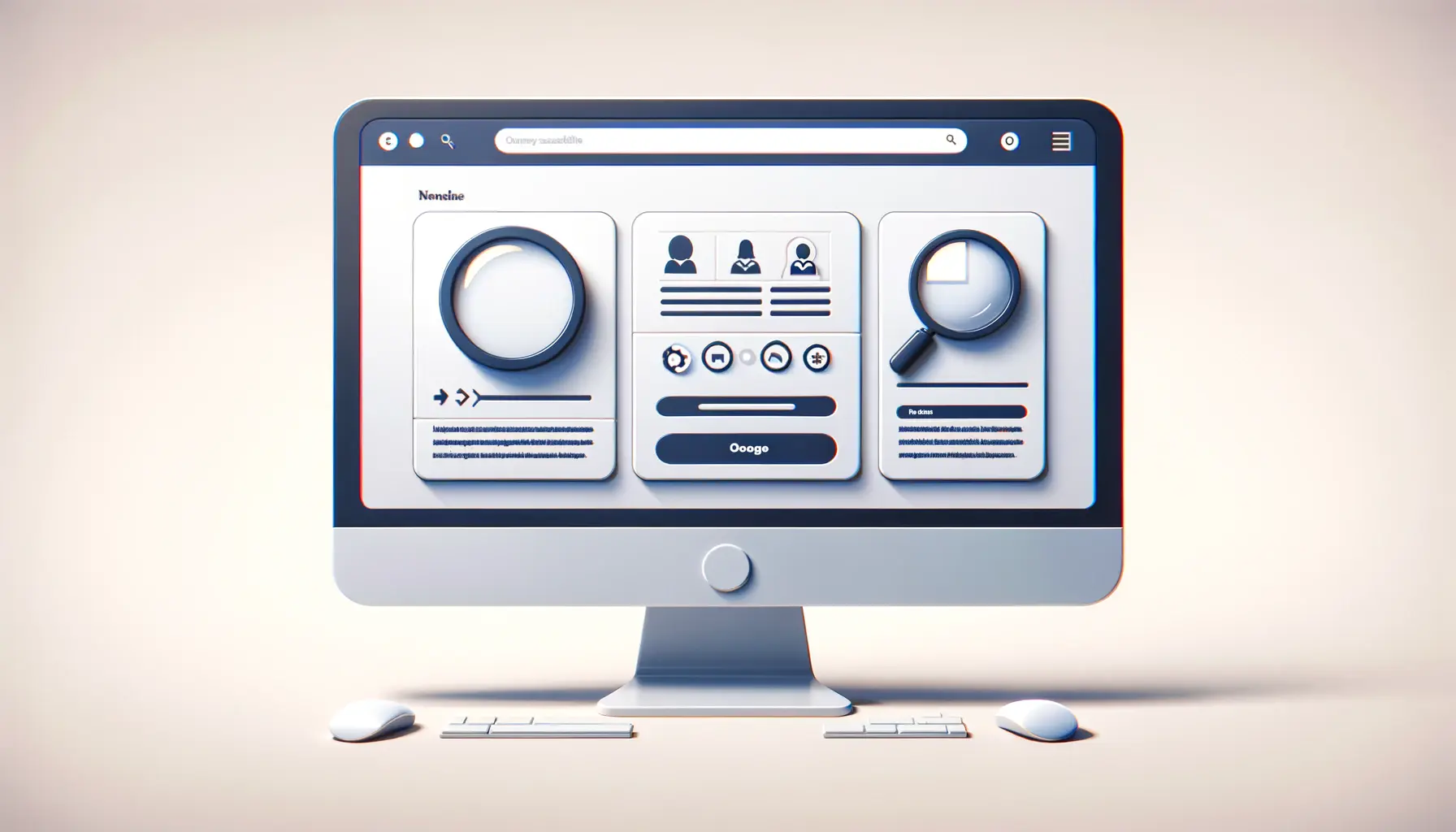In today’s digital age, ensuring that websites are accessible to all users, including those with disabilities, is not just a matter of ethical responsibility but also a legal requirement.
The importance of web accessibility has been underscored by various legal frameworks and guidelines designed to promote an inclusive digital environment.
This article delves into the intricate landscape of legal requirements governing web accessibility, offering insights into how organizations can navigate these obligations to create more accessible and inclusive online spaces.
The concept of web accessibility encompasses a range of practices and technologies designed to make online content usable by people with diverse abilities.
This includes individuals with visual, auditory, motor, and cognitive impairments.
As the internet becomes increasingly integral to daily life, ensuring equitable access to digital resources has emerged as a critical concern, prompting legislative bodies worldwide to enact laws and regulations aimed at eliminating barriers to digital accessibility.
- Understanding Web Accessibility Laws
- Key Legislation and Guidelines Across the Globe
- Challenges and Solutions in Achieving Web Accessibility
- Benefits of Prioritizing Web Accessibility
- Best Practices for Web Accessibility Implementation
- Accessibility Tools and Resources
- Future Trends in Web Accessibility
- Embracing the Future of Web Accessibility
- Frequently Asked Questions on Navigating Legal Requirements for Web Accessibility
Understanding Web Accessibility Laws
At the heart of the legal landscape for web accessibility are two pivotal standards: the Americans with Disabilities Act (ADA) in the United States and the Web Content Accessibility Guidelines (WCAG) developed by the World Wide Web Consortium (W3C).
The ADA, a civil rights law prohibiting discrimination based on disability, has been interpreted to include digital spaces as places of public accommodation.
Consequently, websites failing to meet accessibility standards can face legal challenges under the ADA.
The WCAG serves as the international standard for web accessibility, outlining specific criteria that websites should meet to be considered accessible.
These guidelines are organized into three levels of conformance: A (the minimum level), AA (the standard level for most websites), and AAA (the highest level).
Adhering to WCAG 2.1 AA is widely regarded as a best practice for achieving legal compliance and ensuring that websites are accessible to a broad range of users.
Legal Implications of Non-Compliance
The legal implications of failing to comply with web accessibility requirements can be significant.
In recent years, there has been a notable increase in litigation related to web accessibility, with businesses and organizations facing lawsuits for not making their websites accessible to individuals with disabilities.
These legal actions not only highlight the importance of compliance but also underscore the potential financial and reputational risks associated with non-compliance.
Beyond the threat of litigation, non-compliance with web accessibility laws can also result in missed opportunities and a narrower customer base.
By neglecting accessibility, organizations limit their reach and exclude a significant segment of the population that could otherwise engage with their digital content.
This not only affects individuals with disabilities but also impacts the elderly and those with temporary impairments, further emphasizing the need for inclusive web design.
Ensuring web accessibility is not only a legal obligation but also a strategic advantage, expanding an organization’s reach and fostering inclusivity.
Key Legislation and Guidelines Across the Globe
The legal requirements for web accessibility vary significantly across different countries and regions, reflecting a global commitment to digital inclusivity.
While the ADA and WCAG serve as foundational frameworks in the United States and internationally, several other countries have developed their own laws and guidelines to address the specific needs of their populations.
Understanding these diverse legal landscapes is crucial for organizations operating in multiple jurisdictions.
- European Union (EU): The EU has adopted Directive (EU) 2016/2102, requiring public sector bodies’ websites and mobile apps to be accessible. This directive aligns closely with the WCAG 2.1 AA standards, emphasizing the EU’s commitment to digital accessibility.
- Canada: Canada’s Accessible Canada Act (ACA) aims to make Canada barrier-free by 2040. The ACA, along with provincial laws like the Accessibility for Ontarians with Disabilities Act (AODA), mandates web accessibility for both public and private sector organizations, adhering to WCAG 2.0 or 2.1 AA standards.
- United Kingdom (UK): The UK enforces the Equality Act 2010, which requires websites to be accessible to users with disabilities. Additionally, the Public Sector Bodies (Websites and Mobile Applications) Accessibility Regulations 2018 mandate that public sector websites and apps meet WCAG 2.1 AA standards.
- Australia: The Disability Discrimination Act 1992 (DDA) in Australia mandates that services provided through the web be accessible to people with disabilities. The Australian government also endorses the WCAG 2.1 standards as best practice for web accessibility.
Implementing Accessibility in Web Design
Complying with these legal requirements necessitates a proactive approach to web design and development.
Implementing accessibility from the outset not only mitigates legal risks but also enhances the user experience for all visitors.
Key strategies for incorporating accessibility into web design include:
- Conducting regular accessibility audits to identify and address potential barriers.
- Ensuring that web content is perceivable, operable, understandable, and robust, in line with WCAG principles.
- Providing alternative text for non-text content, such as images and videos, to aid users who rely on screen readers.
- Designing navigable websites that can be easily used with a keyboard or through voice commands, catering to users with motor impairments.
- Maintaining a clear and consistent layout and design to support users with cognitive disabilities.
Incorporating accessibility into web design is not just about adhering to legal standards; it’s about embracing the diversity of the web’s users and creating an inclusive digital world.
Challenges and Solutions in Achieving Web Accessibility
Achieving web accessibility is fraught with challenges, ranging from technical difficulties to lack of awareness.
However, with strategic planning and implementation, these hurdles can be overcome.
Identifying common obstacles and deploying effective solutions is key to ensuring web accessibility compliance and fostering an inclusive online environment.
Technical Complexities
One of the primary challenges in achieving web accessibility is the technical complexity involved in retrofitting existing websites to meet accessibility standards.
Many websites were built without accessibility in mind, leading to significant structural issues that can be costly and time-consuming to address.
To mitigate these challenges, organizations should:
- Adopt a proactive approach by incorporating accessibility into the design phase of new digital projects.
- Utilize automated testing tools to identify accessibility issues, supplemented by manual testing to capture nuances that automated tools may miss.
- Engage with accessibility experts or consultants who can provide guidance on best practices and solutions for complex technical issues.
Lack of Awareness and Training
Another significant barrier to web accessibility is the lack of awareness and understanding of accessibility principles among web developers, designers, and content creators.
Without proper training, these key stakeholders may inadvertently create or perpetuate accessibility barriers.
Organizations can address this issue by:
- Implementing comprehensive training programs focused on web accessibility best practices and legal requirements.
- Encouraging a culture of inclusivity where accessibility is viewed as an integral aspect of quality assurance and user experience.
- Making accessibility resources and guidelines readily available to all team members involved in web development and content creation.
Effective training and a proactive approach to web design are essential for overcoming the technical and knowledge-based challenges of web accessibility.
Benefits of Prioritizing Web Accessibility
While meeting legal requirements is a significant motivator for prioritizing web accessibility, the benefits extend far beyond compliance.
Embracing accessibility can yield substantial advantages for organizations, enhancing their reputation, expanding their audience, and improving the overall user experience.
Enhanced Brand Reputation and Corporate Social Responsibility
Organizations that prioritize web accessibility are often viewed as socially responsible, earning positive recognition from consumers, advocacy groups, and the broader community.
This commitment to inclusivity can significantly enhance a brand’s reputation, demonstrating a dedication to equality and diversity.
By actively promoting web accessibility initiatives, companies not only comply with legal standards but also position themselves as leaders in corporate social responsibility.
This can lead to increased customer loyalty, brand advocacy, and a competitive edge in the marketplace.
Expanded Market Reach and Audience Engagement
Web accessibility opens up digital content to a wider audience, including the millions of users with disabilities.
By removing barriers to access, organizations can tap into new market segments and engage with users who were previously excluded.
This expanded reach is not limited to individuals with permanent disabilities; it also benefits those with temporary impairments, the elderly, and users with situational limitations.
Ensuring that websites are accessible to all users, regardless of their physical or cognitive abilities, can significantly increase an organization’s potential customer base and audience engagement.
Improved User Experience and SEO
Many web accessibility practices align with principles of good web design and search engine optimization (SEO).
For example, providing alternative text for images not only aids users who rely on screen readers but also improves a website’s SEO by allowing search engines to better understand and index the content.
Furthermore, accessible websites tend to have cleaner code, faster loading times, and a more navigable structure, all of which contribute to an improved user experience for all visitors, not just those with disabilities.
This can lead to higher satisfaction rates, increased time on site, and improved conversion rates.
Prioritizing web accessibility is a win-win strategy that enhances user experience, expands audience reach, and fosters a positive brand image, all while ensuring compliance with legal requirements.
Best Practices for Web Accessibility Implementation
Implementing web accessibility effectively requires a strategic approach that encompasses various aspects of web design and development.
By adhering to best practices, organizations can ensure their digital content is accessible to all users, including those with disabilities.
Here are key strategies to consider in your web accessibility implementation plan.
Developing an Accessibility Policy
Establishing a clear web accessibility policy is the foundation of a successful implementation strategy.
This policy should outline your organization’s commitment to accessibility, define specific goals and standards (such as WCAG 2.1 AA compliance), and assign responsibilities for achieving these objectives.
To create an effective accessibility policy, consider the following steps:
- Define the scope of the policy, including all digital properties it will cover.
- Specify the accessibility standards and guidelines your organization will follow.
- Assign roles and responsibilities for implementing and monitoring the policy.
- Establish timelines and benchmarks for achieving accessibility goals.
- Include procedures for receiving and addressing feedback from users regarding accessibility issues.
Incorporating Accessibility into the Web Development Lifecycle
Integrating accessibility considerations into every stage of the web development lifecycle ensures that accessibility is not an afterthought but a fundamental aspect of your digital content.
This approach involves:
- Conducting accessibility audits during the planning phase to identify potential barriers.
- Ensuring web designers and developers are trained in accessibility best practices.
- Incorporating accessibility testing into the quality assurance process, using both automated tools and manual testing by users with disabilities.
- Maintaining accessibility standards during content creation by providing guidelines for content creators on how to produce accessible content.
- Regularly reviewing and updating digital content and technologies to address emerging accessibility challenges.
Engaging with Users with Disabilities
Engaging directly with users who have disabilities can provide invaluable insights into the effectiveness of your web accessibility efforts.
Consider establishing feedback mechanisms, such as surveys or user testing groups, to gather input from users with diverse abilities.
This feedback can highlight areas for improvement and help prioritize accessibility enhancements.
Additionally, collaborating with disability advocacy groups or consulting with accessibility experts can further enhance your organization’s understanding of accessibility challenges and solutions.
True accessibility is achieved not just by following technical guidelines but by understanding and addressing the real-world experiences of users with disabilities.
Accessibility Tools and Resources
Effectively implementing web accessibility requires the right tools and resources.
Fortunately, there are numerous accessibility tools available that can assist organizations in evaluating and improving the accessibility of their digital content.
Utilizing these tools is a critical step in ensuring compliance with web accessibility standards and enhancing the user experience for individuals with disabilities.
Automated Accessibility Testing Tools
Automated testing tools play a vital role in identifying accessibility issues on websites.
These tools can quickly scan web pages for common accessibility problems, providing a baseline assessment of a site’s accessibility.
Some popular automated testing tools include:
- WAVE (Web Accessibility Evaluation Tool): Offers a visual representation of potential accessibility issues directly on the web page.
- AXE: Integrates with web development tools to test for accessibility issues during the development process.
- Lighthouse: An open-source, automated tool by Google that audits web pages for accessibility, performance, and more.
While automated tools are efficient for detecting certain types of accessibility issues, they cannot identify all potential barriers.
Therefore, these tools should be used in conjunction with manual testing and user feedback.
Manual Testing and User Feedback
Manual testing involves evaluating a website or application’s accessibility through direct interaction, simulating the experience of users with disabilities.
This can include navigating the site using keyboard-only controls, employing screen readers, and testing with various assistive technologies.
Engaging real users with disabilities in the testing process provides authentic insights into the usability of your digital content.
Gathering user feedback is also crucial for understanding the effectiveness of your accessibility efforts.
Implementing feedback mechanisms, such as surveys or contact forms specifically for accessibility feedback, can help identify areas for improvement.
Accessibility Guidelines and Resources
Beyond tools, several guidelines and resources are available to assist organizations in their web accessibility initiatives:
- The Web Content Accessibility Guidelines (WCAG): The primary international standards for web accessibility, providing detailed criteria for making web content more accessible.
- ADA Standards for Accessible Design: Provides information on the legal requirements for accessibility under the Americans with Disabilities Act.
- Web Accessibility Initiative (WAI) Resources: Offers a wide range of resources, including tutorials, guidelines, and strategies for implementing web accessibility.
Leveraging both automated and manual testing tools, along with adhering to established accessibility guidelines, forms the cornerstone of a comprehensive web accessibility strategy.
Future Trends in Web Accessibility
The landscape of web accessibility is continually evolving, driven by technological advancements, legal developments, and changing societal attitudes towards inclusivity.
As we look towards the future, several trends are likely to shape the direction of web accessibility, offering both challenges and opportunities for organizations committed to digital inclusivity.
Advancements in Assistive Technologies
Emerging technologies are set to offer more sophisticated solutions to assist individuals with disabilities.
Innovations in artificial intelligence (AI), voice recognition software, and augmented reality (AR) are expected to enhance the capabilities of assistive technologies, making digital content more accessible and interactive.
Organizations will need to stay abreast of these advancements to ensure their digital offerings are compatible with the latest assistive tools.
Increased Legal and Regulatory Focus
As awareness of the importance of digital accessibility grows, so too does the likelihood of more stringent legal and regulatory requirements.
Countries around the world are beginning to recognize the need for comprehensive legislation to ensure web accessibility.
Organizations should anticipate and prepare for tighter regulations by proactively adopting accessibility best practices and standards.
Greater Emphasis on Inclusive Design
Inclusive design principles, which focus on creating products and services that are usable and accessible to people with a wide range of abilities, are becoming increasingly central to the web development process.
This shift towards inclusivity not only benefits users with disabilities but also improves the overall user experience for everyone.
By embedding inclusive design practices into their workflows, organizations can create more user-friendly and accessible digital environments.
Expanding Scope of Web Accessibility
The concept of web accessibility is expanding beyond traditional websites and applications to include emerging digital platforms and technologies, such as social media, virtual reality (VR), and the Internet of Things (IoT).
As these technologies become more integrated into daily life, ensuring their accessibility will be crucial.
Organizations will need to consider accessibility in the context of these new digital spaces to ensure no one is left behind.
The future of web accessibility is bright, with technological innovations and a growing emphasis on inclusivity promising to make the digital world more accessible to all. Organizations that embrace these trends and prioritize accessibility will be well-positioned to lead in the creation of an inclusive digital future.
Embracing the Future of Web Accessibility
The journey towards creating an inclusive digital world is both a legal obligation and a moral imperative.
As we’ve explored the complexities and nuances of navigating legal requirements for web accessibility, it’s clear that this is not just about compliance—it’s about opening up the digital realm to everyone, regardless of their abilities.
The future of web accessibility is poised for significant advancements, with emerging technologies and a growing emphasis on inclusive design set to redefine our online experiences.
The Path Forward
Looking ahead, organizations have both opportunities and responsibilities to shape an accessible digital future.
The key to success lies in proactive engagement with web accessibility, from understanding and implementing current legal requirements to anticipating future trends.
By doing so, organizations can not only avoid legal pitfalls but also unlock the vast potential of a truly inclusive digital world.
- Stay informed about evolving legal standards and guidelines to ensure ongoing compliance.
- Leverage the latest technologies and tools to enhance the accessibility of digital content.
- Embed inclusive design principles into the development process to create more user-friendly and accessible digital environments.
- Engage with users with disabilities to gain insights into their experiences and needs, ensuring that digital offerings are truly inclusive.
Creating a Legacy of Inclusivity
The commitment to web accessibility is more than just meeting legal requirements; it’s about contributing to a society where everyone has equal access to information, services, and opportunities online.
By prioritizing accessibility, organizations can lead by example, demonstrating the value of inclusivity and diversity in the digital age.
The legacy of today’s efforts will be a digital world that welcomes all users, setting a new standard for what it means to be truly accessible.
In conclusion, navigating legal requirements for web accessibility is a journey that requires commitment, innovation, and a deep understanding of the diverse needs of web users.
As we move forward, let us embrace the challenges and opportunities that lie ahead, working together to build a digital world that is accessible, inclusive, and open to everyone.
The future of web accessibility is not just about adapting to legal standards—it’s about creating a digital environment where everyone, regardless of their abilities, can thrive.
Quality web design is key for a great website! Check out our service page to partner with an expert web design agency.
Frequently Asked Questions on Navigating Legal Requirements for Web Accessibility
Understanding the legal landscape of web accessibility can be complex. Here are some frequently asked questions to help clarify key points.
Web accessibility ensures that websites are usable by everyone, including individuals with disabilities, by adhering to specific design and development standards.
It allows equal access to information and services online, ensuring inclusivity and compliance with legal standards like the ADA and WCAG.
The Americans with Disabilities Act (ADA) and the Web Content Accessibility Guidelines (WCAG) are key frameworks in the United States.
A fully accessible website meets WCAG criteria, being perceivable, operable, understandable, and robust for all users.
Begin by auditing your site for accessibility issues and then address these by redesigning elements to meet WCAG standards.
Organizations should aim for at least WCAG 2.1 level AA conformance to meet legal requirements and ensure broad accessibility.
Use automated tools for a preliminary check and follow up with manual testing and user feedback for comprehensive assessment.
Any website offering services or information to the public, especially those owned by businesses or funded by state and local governments, must be compliant.











